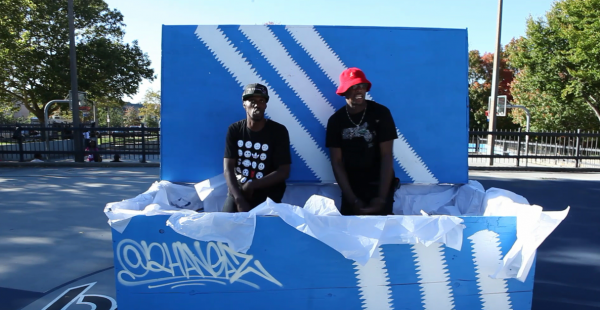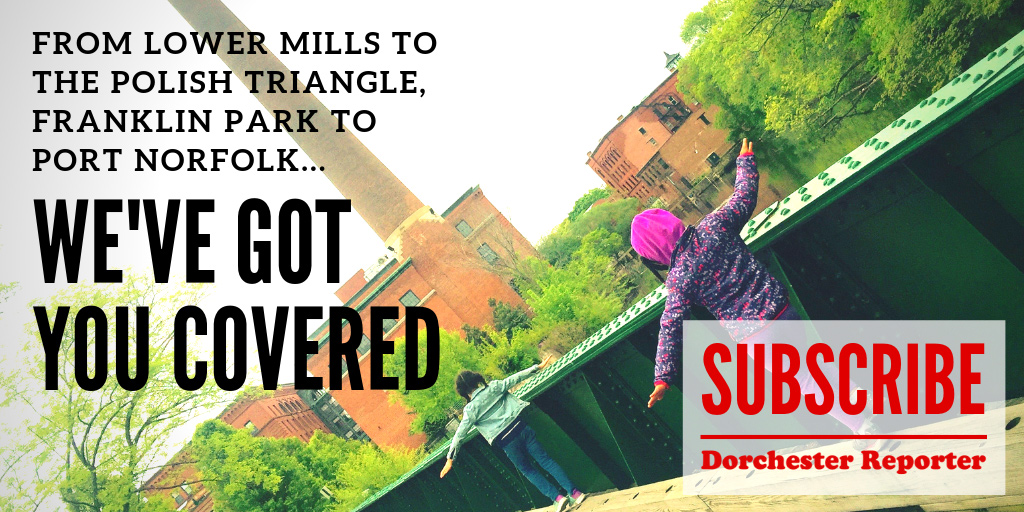September 28, 2017

The Hangaz include Bernard Johnson and Jelani Haynes.
If you make a trip to Malcolm X Park in Roxbury, beside the basketball courts, you’ll see a life-size blue and white Adidas shoebox. The wooden box was built three years ago by Bernard Johnson, a local artist and one-half of Boston rap duo The Hangaz. Johnson, who goes by the stage name Smok n Strok, originally built the box for the music video accompanying his song, “Menag-a-das,” a musical tribute to the sneaker brand close to his heart.
But it has since turned into a community fixture.
“It’s become a landmark,” Johnson says. “It means something to people.”
On any given day you can see people taking pictures with the box. Pickup games are played in its vicinity. Other local artists have even used it in their own videos, Johnson claims.
“People sit on it, they have barbecues on it. The other day, someone got killed in the projects next to the park, and on the box right now there’s a picture of him, there’s candles in front of it.
“This box means so much more to people than I could have ever fathomed it would,” said Johnson. “I knew people would like it but I didn’t know it would have that kind of impact.”
The shoebox is the centerpiece of Johnson’s “Menag-a-das” video, half of a two-part video series premiered by The Hangaz last week at The Greatest Bar entitled “The Shoe’d Out.” The second video, “Consoul,” is the product of Johnson’s rap counterpart, Jelani Haynes, who goes by the stage name Battleaxe. His footwear infatuation? Converse.
“I have a pair for every outfit,” Haynes says proudly.
A line from the first verse of the song describes his affinity for the brand’s flagship model, which he affectionately calls “Chucks.”
“Aspire to be an All-Star.../ I got a constellation in my closet,” he raps.
Converse originated in Malden and is now based in Boston, but enjoys a universal popularity that is nearly unparalleled in the fashion world. The iconic, timeless shoe has been worn by everyone from rock stars to athletes, in countries all over the globe. Haynes says its widespread appeal is part of what makes it special.
“It kind of parallels how I feel about things,” Haynes says. “In one sense, it’s very simple, it’s very plain in terms of the look, but it’s also diverse in terms of the communities that identify with it.”
Haynes explained that the songs and their accompanying music videos, like the respective sneaker brands themselves, give he and Johnson a method of self expression.
“With sneaker culture and fashion being so prevalent in hip-hop, you find identity in the things that you wear,” said Haynes.
This sneaker-identity link is true on a personal level for Johnson, who wears Adidas to honor a friend who was killed back in 2004.
“He used to always wear top tens,” Johnson explains. “So I started wearing Adidas faithfully; I don’t wear any other brands.”
Both members of the rap duo were born and raised in Dorchester, a reality that informs both their music and their roles as representatives and ambassadors of their home. Each acknowledges the ways that their lives and the lives of people around them have been shaped by gun violence.
Haynes was a member of the rap group Graveside until a shooting killed three members in 2005. Yet, they are also aware that media coverage warps the image of everyday life in areas like Dorchester.
“The news will mention one or the other in a particular light,” Haynes says. “I was raised to be community oriented. My family instilled in me understanding the beauty of where you’re from, especially in a city like this where the first thing people want to bring up about Dorchester is the shootings. It’s important that music reflects the beauty, the diversity, the history of what is Dorchester.”
Johnson says that one of the unique challenges facing artists in their position is negotiating how to represent their native town of Dorchester and their native city of Boston at the same time.
“The problem with most [Boston] artists is that when you’re from here, you’re either too hard or too soft. Because of the dynamics of the city, if you’re from our side, chances are your music’s hard. The other side doesn’t always go for that, but that’s where the money and support and everything is at. But if you appease to the people on the other side, how are you keeping people on your side interested without selling out?”
The Hangaz appear to have succeeded in achieving this delicate balance with their song “17 past 6,” a Beantown anthem whose music video features a split-screen effect in which two side-by-side frames depict the two sides of Boston. On one side, Johnson and Haynes ride duck boats in the Charles River; on the other, they pose in front of Roxbury’s Nelson Mandela mural.
The video speaks truth to the complicated nature of a city that is monolithic in some ways but divided in others, especially in terms of race and class. But it also succeeds in delivering an overarching message of solidarity in spite of these social fissures. Toward the end of the video, a wide angle shot shows Johnson and Haynes crouched at the site of the Boston Marathon finish line, heads bowed, fists raised as the hook plays:
“Born and raised, ain’t no place in the world I’d rather be./ I’m the heart beating in the veins and the feeling you embrace when you think about The Bean. Welcome to the six-one-seven.”
This last phrase is looped to form the end of the hook, turning the city’s area code into a chanted rallying cry. This is what Johnson means when he says “This is my city.”


